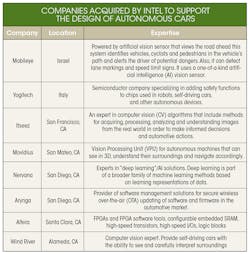According to Morgan Stanley, Americans spend 75 billion hours a year driving. It estimates that self-driving vehicles could deliver $507 billion in annual productivity gains. IHS Markit forecasts as many as 21 million autonomous vehicles will be sold in the year 2035. That’s an awful lot of incentive to be a part of this undertaking.
In the interim and on the road to the autonomous milestone, driver assistance and automated driving technologies will continue to proliferate across all vehicle segments; the latest IHS Markit forecast reflects a 25 percent Compound Annual Growth Rate (CAGR) for the Advanced Driver Assistance System (ADAS) industry between 2017 and 2022 (excluding basic park assist).
Accomplishing a self-driving autonomous car will be “no walk in the park,” it will involve solving a broad range of hardware and software technical challenges. And, the cost will be substantial.
Autonomous cars require a variety of technologies to detect their surroundings, such as Lidar, computer vision, GPS, and odometry. Advanced control systems have to interpret sensory information to identify appropriate navigation paths, as well as obstacles and relevant signage. These cars must also be able to distinguish be different cars on the road.
The purported benefits of autonomous cars include:
- Reduction in traffic collisions
- Fewer injuries
- Less requirement for insurance
- Better traffic flow
- Enhanced mobility for children, the elderly, disabled and poor people
- Relief from driving and navigation chores
- Lower fuel consumption
- Less need for parking space in cities
Among the main obstacles are;
- Technical challenges
- Disputes over liabilities in case of accidents
- Resistance by people to relinquish control of driving
- Safety of driverless cars
- Government regulations
- Possible hackers or terrorists
- Electronic component reliability
- Possible error-free software
A major question is whether you would want yourself or your loved ones to drive in an environment that has autonomous cars? Companies developing these cars are running a horse race, albeit a slow one. These companies are betting a lot of money on their ability to solve the technical problems and then convince the population that self-driving cars are a really a good thing.
Intel has made a series of acquisitions that essentially puts them “in the driver’s seat” of autonomous car competition. But the hard question is how does Intel or anyone else integrate all these technologies into a system that works reliably. Obviously, Intel will employ its own processors to control the flow of information within the car. But, how are they going to make the software from different suppliers talk to each other?
Based on my own experience in checking out a computer-based system, I envision problems that always occur during system checkout involving hardware and software people. When something doesn’t work, the hardware people will accuse the software people that they made a mistake. Or, the software people will accuse the hardware people that they are the cause of the problem. This problem could be compounded because people from different companies and different countries are involved.
Operating power is another factor. All the sensors and all the programs will employ a lot of hardware that consumes power. If this hardware is used in an electric vehicle, power consumption could “go through the roof.” The battery will have to support all the electrical traction drive loads as well as the electronics that make it an autonomous vehicle. Also, the electronic circuits must not be vulnerable to EMI within the car itself as well as other nearby cars.
Another consideration is the car’s maintainability. If Intel is getting hardware from several different suppliers will the circuits be packaged in a similar way with common components? And, what kind of test equipment is required to maintain this type of car?
Eventually, Intel will have to work with a car company to test its systems. Will that prevent them from selling equipment to other car companies?
The end result could be similar to the complexity and sophistication experienced by NASA and the hardware and software suppliers for the Space Program. Only one big difference, there were few financial limits when the U.S. was pursuing its Space Program. In the Automobile World every penny counts as does they weight and size of the car, including the battery.



